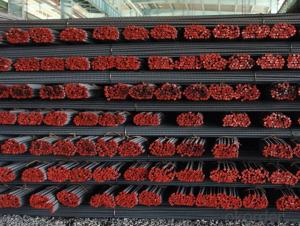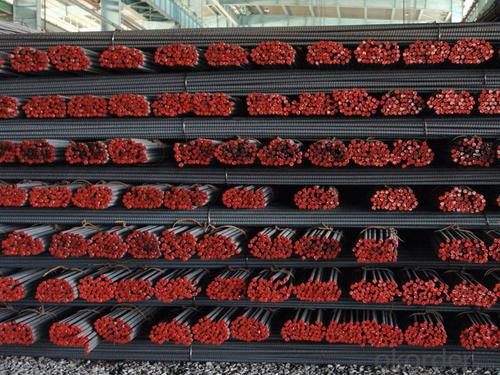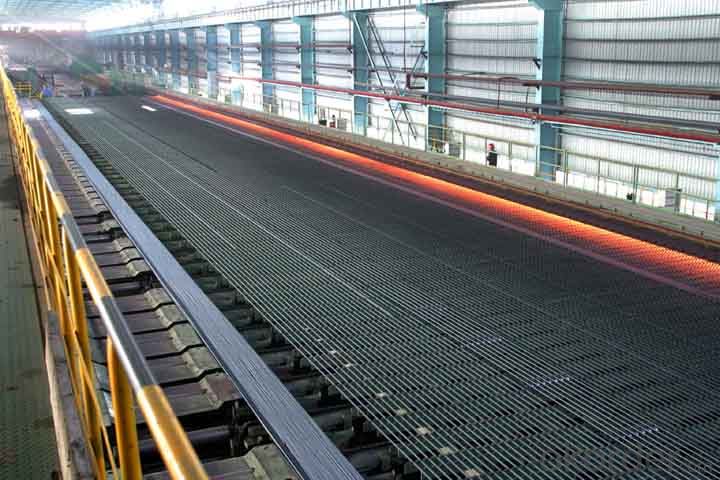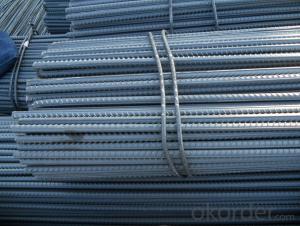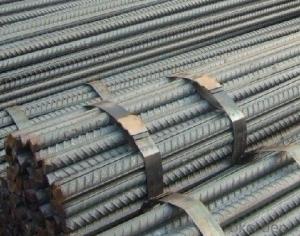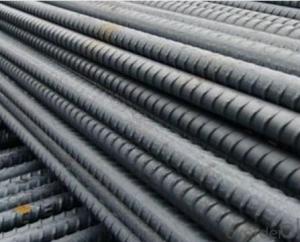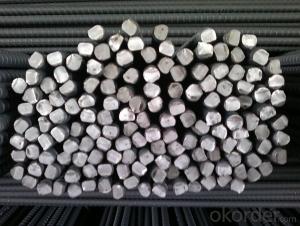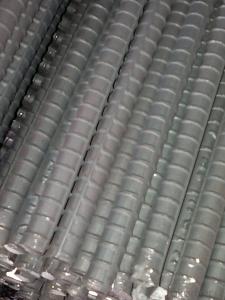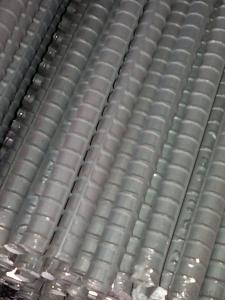Hot Rolled Steel Rebars Deformed bar EN standard
- Loading Port:
- China Main Port
- Payment Terms:
- TT or LC
- Min Order Qty:
- 100 m.t.
- Supply Capability:
- 10000 m.t./month
OKorder Service Pledge
OKorder Financial Service
You Might Also Like
Product Description:
OKorder is offering Hot Rolled Steel Rebars Deformed bar EN standard at great prices with worldwide shipping. Our supplier is a world-class manufacturer of steel, with our products utilized the world over. OKorder annually supplies products to African, South American and Asian markets. We provide quotations within 24 hours of receiving an inquiry and guarantee competitive prices.
Product Applications:
Hot Rolled Steel Rebars Deformed bar EN standard are ideal for structural applications and are widely used in forest region, Mines, factories and construction sites laid of the place such as temporary transport line and light motorcycles with line..
Product Advantages:
OKorder's Hot Rolled Steel Rebars Deformed bar EN standard are durable, strong, and wide variety of sizes.
Main Product Features:
· Premium quality
· Prompt delivery & seaworthy packing (30 days after receiving deposit)
· Can be recycled and reused
· Mill test certification
· Professional Service
· Competitive pricing
Product Specifications:
Manufacture: Hot rolled
Grade: HRB335,HRB400,HRB500
Certificates: ISO, SGS, BV, CIQ
Diameter:6mm-10mm
Packing: products are packed in bundles and shipped by break bulk or containers
Deformed Steel Bar | ||
Diameter (MM) | Cross Sectional Area (MM2) | Theorectical Weight (KG/M) |
6 | 28.27 | 0.222 |
8 | 50.27 | 0.395 |
10 | 78.54 | 0.617 |
12 | 113.1 | 0.888 |
14 | 153.9 | 1.21 |
16 | 201.1 | 1.58 |
18 | 254.5 | 2 |
20 | 314.2 | 2.47 |
22 | 380.1 | 2.98 |
25 | 490.9 | 3.85 |
28 | 615.8 | 4.83 |
32 | 804.2 | 6.31 |
FAQ:
Q1: what is the difference between actual weight and theoretical weight?
A1: All the section steel has two weights: actual weight and theoretical weight. Actual weight is the weighing out when the product delivered from the mill. Theoretical weight is calculated by pieces. The invoice can be based on each of them as your request.
Q2: How do we guarantee the quality of our products?
A2: We have established an advanced quality management system which conducts strict quality tests at every step, from raw materials to the final product. At the same time, we provide extensive follow-up service assurances as required.
Q3: How soon can we receive the product after purchase?
A3: Within three days of placing an order, we will arrange production. The normal sizes with the normal grade can be produced within one month. The specific shipping date is dependent upon international and government factors, the delivery to international main port about 45-60days.
Images:
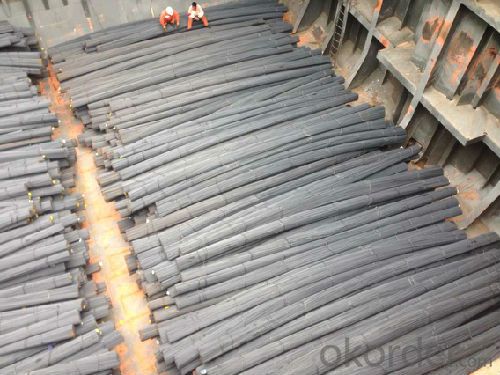

- Q: What are the listed companies that produce wire rod and thread steel?
- The wire in iron and steel usually refers to a coil of wire material with a diameter of 5.5-14. Most of the use of wire coil machine rolled coil supply, it is also known as wire rod or coil. Wire rod is one of the varieties of steel with great dosage. After rolling, it can be directly used for reinforcement and welding structure of reinforced soil, and can also be used again and again. For example, by drawing into a variety of specifications of steel wire, steel wire rope, and then twisted into woven steel wire and winding and heat treatment to the spring; hot and cold forged into cold forging and rolling into rivets and bolts, screws and so on; by cutting into the heat treatment made of mechanical parts or tools; a common wire made of quality carbon steel and carbon steel.
- Q: What is the role of steel rebars in beam and column design?
- Steel rebars play a crucial role in beam and column design as they provide reinforcement and enhance the structural integrity of these elements. In reinforced concrete structures, rebars are used to resist tensile forces that concrete alone cannot withstand. In beams, rebars are typically placed at the bottom to counteract tensile stresses caused by bending moments. By distributing the load across the beam's length, rebars effectively increase its strength and prevent cracking or failure. The rebars' ability to resist tension helps the beam maintain its shape and load-bearing capacity, ensuring the structural stability of the entire construction. Similarly, in columns, rebars are placed throughout the length to resist both axial and bending forces. They improve the column's ability to withstand compression while also providing additional resistance against lateral loads from seismic or wind forces. The presence of rebars in columns significantly enhances their load-bearing capacity and overall stability. In summary, steel rebars play a critical role in beam and column design by providing reinforcement against tensile forces, increasing structural strength, preventing cracking, and ensuring the overall stability and safety of the structure.
- Q: Can steel rebars be used in pedestrian bridge construction?
- Yes, steel rebars can be used in pedestrian bridge construction. Steel rebars are commonly used as reinforcement in concrete structures, including bridges. They enhance the structural integrity and strength of the bridge, ensuring its ability to withstand various loads and forces. Steel rebars provide the necessary reinforcement to resist tension, bending, and shear forces, making them an ideal choice for pedestrian bridge construction. Additionally, steel rebars have excellent durability, corrosion resistance, and are readily available, making them a cost-effective and reliable option for bridge construction.
- Q: How do steel rebars affect the environmental sustainability of a structure?
- Steel rebars can have both positive and negative impacts on the environmental sustainability of a structure. On the positive side, steel rebars provide high strength and durability to the structure, allowing it to withstand the test of time and reduce the need for frequent repairs or replacements. This can result in lower resource consumption and waste generation over the lifespan of the structure. Additionally, steel rebars can be recycled at the end of their life, reducing the demand for new raw materials and minimizing carbon emissions associated with steel production. However, the production of steel rebars involves significant energy consumption and carbon emissions, contributing to climate change. The extraction and processing of iron ore, as well as the manufacturing of steel rebars, require large amounts of energy and can have negative impacts on air and water quality. Furthermore, the transportation of steel rebars to construction sites can also contribute to carbon emissions. To ensure the environmental sustainability of a structure, it is important to consider the entire life cycle of steel rebars, from raw material extraction to end-of-life recycling. Implementing sustainable practices such as using recycled steel, optimizing the design to reduce the amount of steel required, and minimizing transportation distances can help mitigate the negative environmental impacts of steel rebars and promote a more sustainable construction industry.
- Q: Can steel rebars be used in structures with high resistance to fire?
- Yes, steel rebars can be used in structures with high resistance to fire. Steel has a high melting point and excellent fire resistance properties, making it a suitable choice for reinforcing structures that need to withstand high temperatures and fire hazards.
- Q: What is the role of steel rebars in maintaining structural integrity?
- Steel rebars play a crucial role in maintaining structural integrity by reinforcing and strengthening concrete structures. They provide tensile strength to resist cracking, bending, and shearing forces, enhancing the overall stability and durability of buildings, bridges, and other infrastructure.
- Q: Are there any limitations or disadvantages of using steel rebars?
- Yes, there are limitations and disadvantages of using steel rebars. One limitation is that steel rebars can corrode over time, especially in harsh environments or when exposed to moisture. This corrosion can weaken the structure and reduce the lifespan of the reinforced concrete. Additionally, steel rebars have a high thermal expansion coefficient, which can cause cracking or deformation in concrete structures due to temperature changes. Moreover, steel rebars are heavy and require specialized handling and transportation, which can increase construction costs.
- Q: How are steel rebars used in the construction of oil and gas refineries?
- Steel rebars are used in the construction of oil and gas refineries as they provide strength, stability, and durability to the structures. These rebars are typically embedded in concrete foundations and reinforced concrete structures to enhance their load-bearing capacity and resistance against seismic activity. They ensure the integrity and safety of the refinery by reinforcing critical components such as columns, beams, walls, and slabs, making them capable of withstanding the heavy loads and harsh environmental conditions associated with refinery operations.
- Q: Can steel rebars be used in bridges and highways?
- Yes, steel rebars can be used in bridges and highways. Steel rebars are commonly used as reinforcement in concrete structures, including bridges and highways, to enhance their strength and durability. The rebars are embedded within the concrete to provide additional tensile strength, which is crucial for withstanding the various loads and stresses that bridges and highways are subjected to. Steel rebars are preferred due to their high strength-to-weight ratio, corrosion resistance, and ability to bond well with concrete. Additionally, they can be easily fabricated and shaped to suit the design requirements of the bridge or highway. Overall, steel rebars are a vital component in the construction of bridges and highways, ensuring their structural integrity and longevity.
- Q: Can steel rebars be used in high-security facility construction?
- Yes, steel rebars can be used in high-security facility construction. Steel rebars provide enhanced strength and durability, making them suitable for reinforcing structures in high-security facilities where robustness and resistance against external threats are crucial.
Send your message to us
Hot Rolled Steel Rebars Deformed bar EN standard
- Loading Port:
- China Main Port
- Payment Terms:
- TT or LC
- Min Order Qty:
- 100 m.t.
- Supply Capability:
- 10000 m.t./month
OKorder Service Pledge
OKorder Financial Service
Similar products
Hot products
Hot Searches
Related keywords
